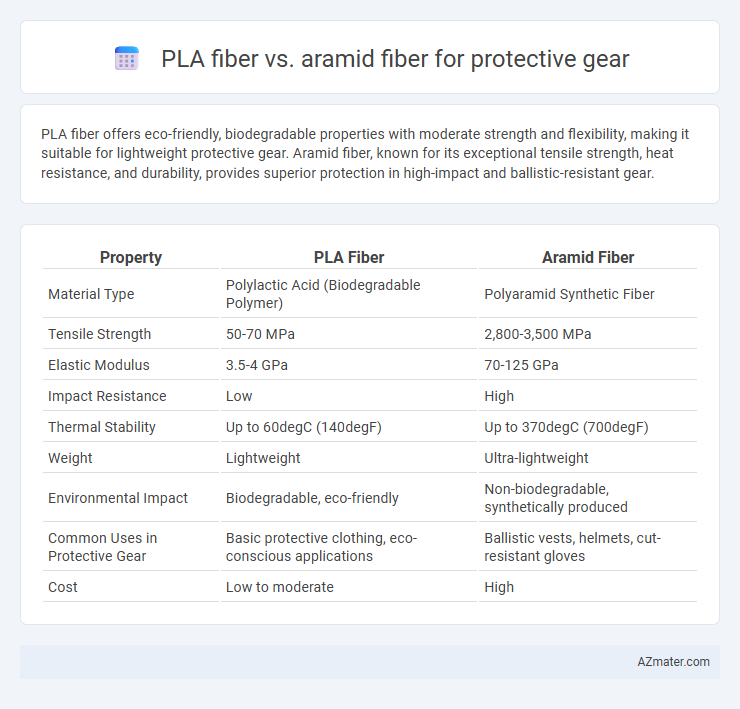PLA fiber offers eco-friendly, biodegradable properties with moderate strength and flexibility, making it suitable for lightweight protective gear. Aramid fiber, known for its exceptional tensile strength, heat resistance, and durability, provides superior protection in high-impact and ballistic-resistant gear.
Table of Comparison
| Property | PLA Fiber | Aramid Fiber |
|---|---|---|
| Material Type | Polylactic Acid (Biodegradable Polymer) | Polyaramid Synthetic Fiber |
| Tensile Strength | 50-70 MPa | 2,800-3,500 MPa |
| Elastic Modulus | 3.5-4 GPa | 70-125 GPa |
| Impact Resistance | Low | High |
| Thermal Stability | Up to 60degC (140degF) | Up to 370degC (700degF) |
| Weight | Lightweight | Ultra-lightweight |
| Environmental Impact | Biodegradable, eco-friendly | Non-biodegradable, synthetically produced |
| Common Uses in Protective Gear | Basic protective clothing, eco-conscious applications | Ballistic vests, helmets, cut-resistant gloves |
| Cost | Low to moderate | High |
Introduction to PLA and Aramid Fibers
PLA fiber, derived from renewable resources such as corn starch, offers biodegradability and lightweight properties, making it an eco-friendly option in protective gear applications. Aramid fiber, known for its exceptional strength, heat resistance, and high tensile strength, is widely used in bulletproof vests and helmets due to its superior durability and impact resistance. The contrasting characteristics of PLA and aramid fibers highlight the trade-off between sustainability and maximum protective performance in designing advanced personal armor.
Material Composition and Origins
PLA fiber, derived from renewable resources such as corn starch or sugarcane, is a biodegradable polyester known for its eco-friendly origin and lightweight properties. Aramid fiber, synthesized from aromatic polyamide polymers, originates from petrochemical sources and offers exceptional strength, heat resistance, and durability ideal for high-performance protective gear. The fundamental differences in material composition between bio-based PLA and synthetic aramid lead to distinct applications, with aramid favored for ballistic protection and PLA used in more sustainable, less demanding safety equipment.
Mechanical Strength Comparison
PLA fiber exhibits moderate tensile strength and stiffness but falls short in impact resistance compared to Aramid fiber, which is engineered for high tensile strength exceeding 3,000 MPa and exceptional toughness. Aramid fiber's superior mechanical properties provide enhanced abrasion resistance, durability, and ballistic performance vital for protective gear applications. PLA fiber's biodegradability offers environmental benefits but limits its use where maximum mechanical strength is required.
Thermal Resistance and Heat Tolerance
PLA fiber exhibits lower thermal resistance and heat tolerance compared to Aramid fiber, making it less suitable for high-temperature protective gear applications. Aramid fiber, notably used in Kevlar and Nomex, demonstrates exceptional heat resistance withstanding temperatures up to 370degC (700degF) without melting or degrading. Its superior thermal stability and flame retardant properties ensure reliable protection in extreme heat environments, outperforming biodegradable PLA fibers.
Weight and Comfort in Wearables
PLA fiber offers lightweight properties and biodegradability, making it an eco-friendly choice for protective gear focused on comfort. Aramid fiber, known for its superior strength and thermal resistance, is heavier but provides enhanced protection in harsh conditions. Comparing their wearability, PLA fibers excel in comfort and flexibility, while aramid fibers prioritize durability and safety in high-impact scenarios.
Biodegradability and Environmental Impact
PLA fiber, derived from renewable resources like corn starch, offers excellent biodegradability, breaking down under industrial composting conditions within months and significantly reducing long-term environmental pollution. Aramid fiber, known for its high strength and heat resistance, is non-biodegradable and persists in landfills for decades, contributing to environmental accumulation and challenging waste management. Choosing PLA fiber for protective gear minimizes ecological footprint due to its sustainable lifecycle, while aramid fibers provide superior durability but pose greater environmental concerns after disposal.
Cost and Production Efficiency
PLA fiber offers a cost-effective alternative to aramid fiber due to its lower raw material and manufacturing expenses, making it suitable for budget-conscious protective gear production. Its biodegradable nature and compatibility with standard processing techniques enhance production efficiency, enabling faster and more sustainable manufacturing cycles. In contrast, aramid fiber, known for its high strength and thermal resistance, incurs higher costs and longer production times due to complex synthesis and processing requirements.
Durability and Wear Resistance
Aramid fiber, known for exceptional tensile strength and heat resistance, outperforms PLA fiber in durability and wear resistance for protective gear applications. PLA fiber, derived from renewable resources, offers lower abrasion resistance and tends to degrade under prolonged mechanical stress and high temperatures. Protective gear utilizing aramid fibers such as Kevlar delivers superior longevity and enhanced protection against cuts, punctures, and thermal hazards compared to PLA-based materials.
Application Suitability in Protective Gear
PLA fiber offers lightweight and biodegradable properties, making it suitable for disposable protective gear and temporary applications where environmental impact is a concern. Aramid fiber, renowned for its exceptional tensile strength, heat resistance, and ballistic protection, is the preferred material for high-performance body armor, helmets, and gloves designed for military, law enforcement, and firefighting use. The choice between PLA and aramid fibers depends heavily on the balance between sustainability and the level of protection required.
Future Trends in Protective Fiber Innovation
PLA fiber and aramid fiber both play crucial roles in the evolution of protective gear, with PLA offering eco-friendly, biodegradable alternatives and aramid fibers providing unmatched heat resistance and tensile strength. Research is trending towards hybrid composites combining PLA's sustainability with aramid's durability to enhance protective performance while minimizing environmental impact. Emerging nanotechnology integration and bio-based additives are expected to further optimize fiber functionality, leading to next-generation protective materials with superior strength, lightweight properties, and biodegradability.

Infographic: PLA fiber vs Aramid fiber for Protective gear
 azmater.com
azmater.com